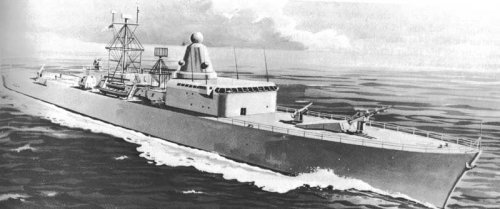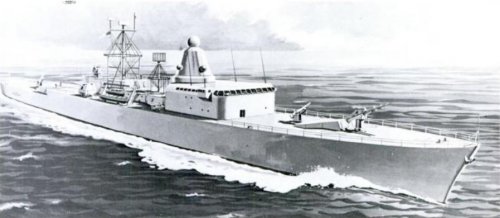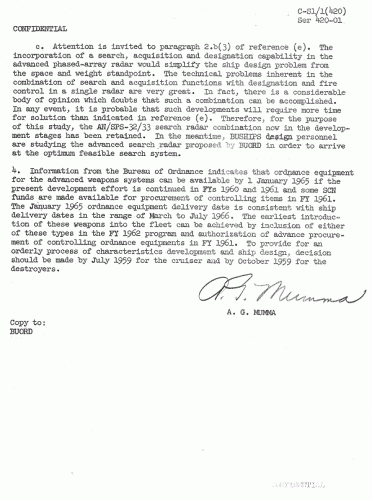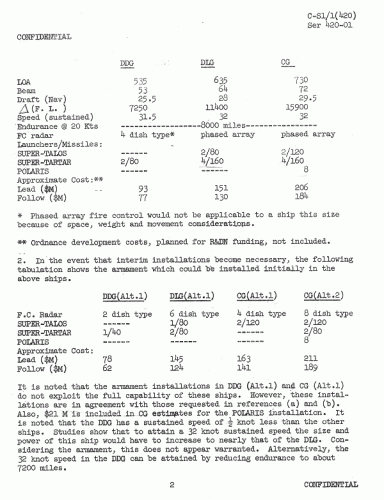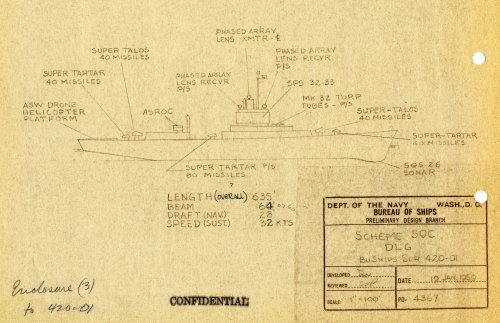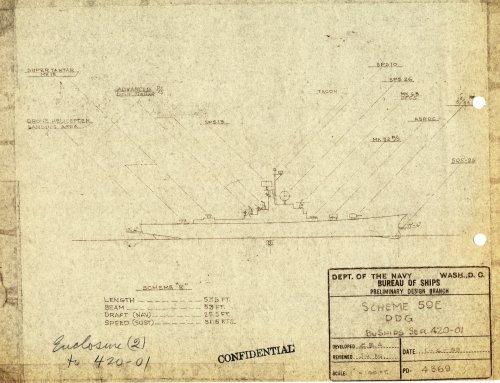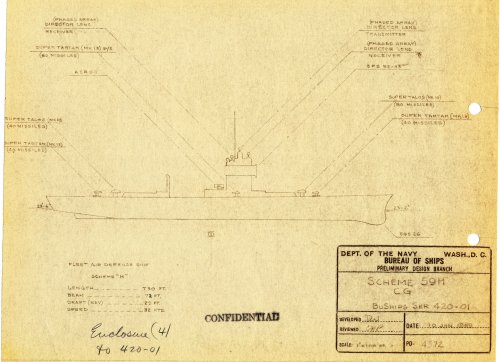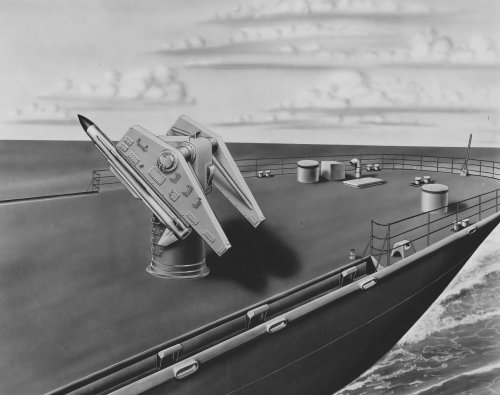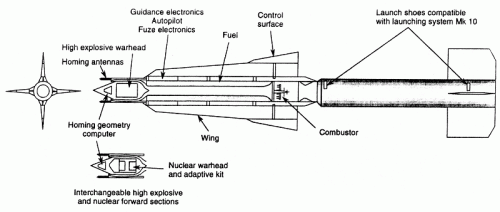- Joined
- 3 June 2011
- Messages
- 17,897
- Reaction score
- 10,978
Having been home ported at Port Hueneme, California since 30 November 1948, Norton Sound stood out to sea in June of 1962 bound for Norfolk, Virginia and ultimately to Baltimore, Maryland. She arrived at Norfolk, Virginia and was decommissioned on 10 August 1962, and was later towed to Baltimore to enter the Maryland Shipbuilding and Drydock Co. shipyard for installation of major portions of the prototype TYPHON Weapons System, which consisted of the AN/SPG-59 Radar and its associated control system. TYPHON was a radical step in the evolution of naval surface weapons systems, being the first system capable of simultaneously taking multiple targets under fire and tracking many more.
Unfortunately, the electronic state of the art at that time was not capable of providing the necessary components in the size required to build a system deployable in a destroyer. The TYPHON Programs was cancelled on 7 January 1964 by Secretary of Defense Robert S. McNamara. Therefore, it was decided that the installation in Norton Sound would be used to gather data which would help advance the state of the art, and prepare the way for development of a serviceable small ship system at a later date.
Completing the conversion, USS Norton Sound (AVM-1) was re-commissioned on 20 June 1964, and home ported in Baltimore to conduct tests of the system in and around the Chesapeake Bay. Her home port was again changed to Port Hueneme, California, she arrived there on 7 July 1965. Testing of the TYPHON System was continued out of Port Hueneme for a time and then most of the system was removed, including the 190 ton Radar tower, at Long Beach Naval Shipyard, with work being completed on 30 September 1966. Although TYPHON did not survive to serve in the fleet, many of the lessons learned were applied to the development of the AEGIS Weapon System, when the Norton Sound became the test bed for the AEGIS project.
Chronology of USS Norton Sound (AVM-1), 1941-1986
Named for the largest Alaskan Sound; she was the Navy's first guided missile test ship; home port, Port Hueneme, CA
Keel laid in San Pedro Shipyard.
1943:
Ship outfitted by Todd Shipyards Corp. Launched and christened 28 November.
1945:
Commissioned 8 January. CDR Ben S. Custer, USN, in command. Norton Sound (AV-11) was the first seaplane tender and the largest ship ever built in Los Angeles Harbor area. Her armament, including four 5-inch guns and twenty 40-millimeter antiaircraft guns, was put to the test during her first six months when she found herself participating in the closing campaigns of World War II with the Pacific Fleet.
1946 -1949:
This period included a brief repair period followed by modification at the Philadelphia Naval Shipyard to become a guided missile test ship. She then returned to the Pacific to again tend seaplanes.
1949:
AEROBEE - Installation of launching equipment; two successful launches to obtain data on cosmic radiation.
SKYHOOK - Seventeen SKYHOOK balloons carrying over 100 pounds of instrumentation were tracked by the ship's radar while collecting data concerning cosmic radiation. 1950:
Fitted with launch and control equipment designed for the five-ton VIKING research rocket, to carry cosmic radiation instruments.
In the fall, new equipment was installed for operations with TERRIER missiles.
1955:
Reclassified as a guided missile ship (AVM-1). Research, development, and evaluation launchings of TERRIER missiles continued through 1955.
1956:
Operation RIFF-RAFF demonstrated the first launch and control of two Regulus guided missiles.
1957:
Helicopter landing deck removed. Helicopters continued landing on her large afterdeck.
1958:
Surface-to-Surface target boats used in conjunction with ongoing TARTAR and TERRIER missile experiments. Test launchings continued through 1969.
1960:
Terrier Operational Proof High Altitude Target (TOP HAT) operations determined the feasibility of using TERRIER missiles as high performance realistic targets for advanced missiles.
1962:
Decommissioned and prepared for the installation of the TYPHON Weapon Control System. This weapon system was being developed to defend carrier task forces against Soviet strike aircraft and their antiship missiles. Its capabilities surpassed the existing 3-T's (TERRIER, TALOS, TARTAR) missile systems. In the following two-year period, another deck level was added for TYPHON's phased array-type radar.
1964:
Recommissioned, now more than a launching platform for missiles, she was equipped for searching, tracking and controlling the attack of the new TYPHON all the way to interception. This program lasted through 1965.
1965:
Fired the first successful SEA SPARROW missile, to provide short range or "point" defense for U.S. warships.
1968:
Mark 45, a new lightweight 5"/54 gun, installed for testing. This was the first new major gun system produced by the United States during the last two decades.
1969:
Centralized Automatic Testing Systems (CATS) installed to assess the performance of electronic systems.
Other short-term missile firings also took place, to test the feasibility of achieving rocket accuracy through different launch techniques.
1970:
Testing of Mark 86 Gun Fire Control System.
1972
Made first deployment in many years. Temporairly based in and out of American Samoa (Pango Pango). Also visited Pearl Harbor Hawaii, several times during the deployment. This trip is believed to be the only time the Norton Sound ever crossed the equator and she made it across twice during the deployment.
1972 -1973:
Installation of engineering development model (EDM-1) of the AEGIS Weapon System takes place.
1974:
System integration testing commenced. A stringent missile firing program continued. Navy personnel were trained to operate and maintain the system.
1975:
Preparation for the first all-Navy Preliminary Evaluation (NPE) continued through the beginning of 1975.
1975:
AEGIS, entirely Navy-operated, engaged and shot down three missiles, including a low-altitude supersonic TALOS Missile configured for target drone use.
CDR D.B. Dickmann relived CDR J.R. Poole as Commanding Officer.
1976:
AEGIS in AVM-1 participated actively in the five-nation fleet exercise, "VALIANT HERITAGE."
ADM M. Weismer (CINCPACFLT) visited for AEGIS briefings.
Tests demonstrated AEGIS could fire both SM-1 and SM-2 missiles.
AEGIS scored a direct hit on a SEPTAR configured boat in its first surface-to-surface firing.
AEGIS fired its first SM-2 and scored a direct hit on a BOM-34A target drone.
1977:
Ship and system testing continued.
CDR T.J. Loftus relieved CDR B.D. Dickmann as Commanding Officer.
"SUPER SUNDAY" – Mark 26 Guided Missile Launching System (GMLS) Sustained Firing Test conducted. These tests demonstrated the capability of the launching system to support rapid missile firings on a sustained basis.
1978:
Preparation made for AEGIS/SM-2 engagements of High Altitude Supersonic Targets (HAST).
Two separate HAST engagements were successfully completed, demonstrating antiship missile attack capability.
First foreign port of call with AEGIS aboard; the ship paid a good-will visit to the Canadian Naval base at Victoria.
Major overhaul, including modification for Vertical Launching System installation, took place.
1979:
Norton Sound returned to sea and resumed testing program. Sustained Firing Tests using the GMLS Mark 26 demonstrated the firing of 12 modified improved TARTAR warhead missiles.
"CENTURION" was painted on the launcher arm to signify the successful completion of more than 100 missile firings.
BUZZARDEX- a new fleet record was set for a successful defense against TALOS missile (BUZZARD) targets.
1981:
"TRIUMPHANT THURSDAY" became the day two standard missiles were fired in rapid succession from the Vertical Launching System, scoring two direct hits on two separate BOM-34A drone target aircraft.
1985:
Norton Sound celebrated her 40th year of service to the Navy.
1986:
Decommissioned 16 December. Future testing to take place aboard AEGIS cruisers.
1988:
Disposed of by Maritime Administration (MARAD).
Unfortunately, the electronic state of the art at that time was not capable of providing the necessary components in the size required to build a system deployable in a destroyer. The TYPHON Programs was cancelled on 7 January 1964 by Secretary of Defense Robert S. McNamara. Therefore, it was decided that the installation in Norton Sound would be used to gather data which would help advance the state of the art, and prepare the way for development of a serviceable small ship system at a later date.
Completing the conversion, USS Norton Sound (AVM-1) was re-commissioned on 20 June 1964, and home ported in Baltimore to conduct tests of the system in and around the Chesapeake Bay. Her home port was again changed to Port Hueneme, California, she arrived there on 7 July 1965. Testing of the TYPHON System was continued out of Port Hueneme for a time and then most of the system was removed, including the 190 ton Radar tower, at Long Beach Naval Shipyard, with work being completed on 30 September 1966. Although TYPHON did not survive to serve in the fleet, many of the lessons learned were applied to the development of the AEGIS Weapon System, when the Norton Sound became the test bed for the AEGIS project.
Chronology of USS Norton Sound (AVM-1), 1941-1986
Named for the largest Alaskan Sound; she was the Navy's first guided missile test ship; home port, Port Hueneme, CA
Keel laid in San Pedro Shipyard.
1943:
Ship outfitted by Todd Shipyards Corp. Launched and christened 28 November.
1945:
Commissioned 8 January. CDR Ben S. Custer, USN, in command. Norton Sound (AV-11) was the first seaplane tender and the largest ship ever built in Los Angeles Harbor area. Her armament, including four 5-inch guns and twenty 40-millimeter antiaircraft guns, was put to the test during her first six months when she found herself participating in the closing campaigns of World War II with the Pacific Fleet.
1946 -1949:
This period included a brief repair period followed by modification at the Philadelphia Naval Shipyard to become a guided missile test ship. She then returned to the Pacific to again tend seaplanes.
1949:
AEROBEE - Installation of launching equipment; two successful launches to obtain data on cosmic radiation.
SKYHOOK - Seventeen SKYHOOK balloons carrying over 100 pounds of instrumentation were tracked by the ship's radar while collecting data concerning cosmic radiation. 1950:
Fitted with launch and control equipment designed for the five-ton VIKING research rocket, to carry cosmic radiation instruments.
In the fall, new equipment was installed for operations with TERRIER missiles.
1955:
Reclassified as a guided missile ship (AVM-1). Research, development, and evaluation launchings of TERRIER missiles continued through 1955.
1956:
Operation RIFF-RAFF demonstrated the first launch and control of two Regulus guided missiles.
1957:
Helicopter landing deck removed. Helicopters continued landing on her large afterdeck.
1958:
Surface-to-Surface target boats used in conjunction with ongoing TARTAR and TERRIER missile experiments. Test launchings continued through 1969.
1960:
Terrier Operational Proof High Altitude Target (TOP HAT) operations determined the feasibility of using TERRIER missiles as high performance realistic targets for advanced missiles.
1962:
Decommissioned and prepared for the installation of the TYPHON Weapon Control System. This weapon system was being developed to defend carrier task forces against Soviet strike aircraft and their antiship missiles. Its capabilities surpassed the existing 3-T's (TERRIER, TALOS, TARTAR) missile systems. In the following two-year period, another deck level was added for TYPHON's phased array-type radar.
1964:
Recommissioned, now more than a launching platform for missiles, she was equipped for searching, tracking and controlling the attack of the new TYPHON all the way to interception. This program lasted through 1965.
1965:
Fired the first successful SEA SPARROW missile, to provide short range or "point" defense for U.S. warships.
1968:
Mark 45, a new lightweight 5"/54 gun, installed for testing. This was the first new major gun system produced by the United States during the last two decades.
1969:
Centralized Automatic Testing Systems (CATS) installed to assess the performance of electronic systems.
Other short-term missile firings also took place, to test the feasibility of achieving rocket accuracy through different launch techniques.
1970:
Testing of Mark 86 Gun Fire Control System.
1972
Made first deployment in many years. Temporairly based in and out of American Samoa (Pango Pango). Also visited Pearl Harbor Hawaii, several times during the deployment. This trip is believed to be the only time the Norton Sound ever crossed the equator and she made it across twice during the deployment.
1972 -1973:
Installation of engineering development model (EDM-1) of the AEGIS Weapon System takes place.
1974:
System integration testing commenced. A stringent missile firing program continued. Navy personnel were trained to operate and maintain the system.
1975:
Preparation for the first all-Navy Preliminary Evaluation (NPE) continued through the beginning of 1975.
1975:
AEGIS, entirely Navy-operated, engaged and shot down three missiles, including a low-altitude supersonic TALOS Missile configured for target drone use.
CDR D.B. Dickmann relived CDR J.R. Poole as Commanding Officer.
1976:
AEGIS in AVM-1 participated actively in the five-nation fleet exercise, "VALIANT HERITAGE."
ADM M. Weismer (CINCPACFLT) visited for AEGIS briefings.
Tests demonstrated AEGIS could fire both SM-1 and SM-2 missiles.
AEGIS scored a direct hit on a SEPTAR configured boat in its first surface-to-surface firing.
AEGIS fired its first SM-2 and scored a direct hit on a BOM-34A target drone.
1977:
Ship and system testing continued.
CDR T.J. Loftus relieved CDR B.D. Dickmann as Commanding Officer.
"SUPER SUNDAY" – Mark 26 Guided Missile Launching System (GMLS) Sustained Firing Test conducted. These tests demonstrated the capability of the launching system to support rapid missile firings on a sustained basis.
1978:
Preparation made for AEGIS/SM-2 engagements of High Altitude Supersonic Targets (HAST).
Two separate HAST engagements were successfully completed, demonstrating antiship missile attack capability.
First foreign port of call with AEGIS aboard; the ship paid a good-will visit to the Canadian Naval base at Victoria.
Major overhaul, including modification for Vertical Launching System installation, took place.
1979:
Norton Sound returned to sea and resumed testing program. Sustained Firing Tests using the GMLS Mark 26 demonstrated the firing of 12 modified improved TARTAR warhead missiles.
"CENTURION" was painted on the launcher arm to signify the successful completion of more than 100 missile firings.
BUZZARDEX- a new fleet record was set for a successful defense against TALOS missile (BUZZARD) targets.
1981:
"TRIUMPHANT THURSDAY" became the day two standard missiles were fired in rapid succession from the Vertical Launching System, scoring two direct hits on two separate BOM-34A drone target aircraft.
1985:
Norton Sound celebrated her 40th year of service to the Navy.
1986:
Decommissioned 16 December. Future testing to take place aboard AEGIS cruisers.
1988:
Disposed of by Maritime Administration (MARAD).




